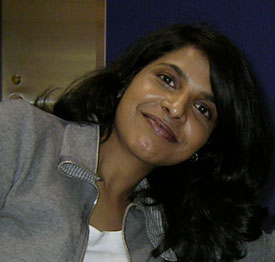Viability Theory Addresses Sustainability and Social Issues
By Karthika Swamy Cohen
During a disease outbreak, what is the minimal percentage of infected people that a city can withstand, given a healthcare budget? The viability theory—which finds initial conditions that can assure a viable future trajectory within a controlled dynamical system under state and control constraints—has addressed these types of questions for decades. This approach focuses on the consistency between a dynamical system and given constraints in the system, typically relying on standards and thresholds.
At the SIAM Conference on Mathematics of Planet Earth being held this week in Philadelphia, Pa., Pedro Gajardo of Universidad Técnica Federico Santa María, Chile, described use of the theory to tackle social problems, such as epidemiology and resource exploitation.
“Viability theory framework is very well adapted for dealing with sustainability issues,” Pedro said. “Assume that in your city you have a disease outbreak. And the healthcare system has a budget constraint. Is it possible to keep infection of people in the city below a certain threshold given these budget constraints?”
The set of sustainable thresholds represents the constraints in the system. For this specific case, for instance, the constraints would be the maximal "allowable" number of human infections—or disease prevalence—and the maximal "affordable" budget for disease prevention and treatment
In the case of disease outbreak in a city, there are two constraints: maximal allowable number of human infections—or disease prevalence—and the maximal affordable budget for disease prevention.
The goal is to determine the set of constraints parametrized by thresholds that can be sustained by applying an admissible control strategy starting at the given initial state and extending through the control intervention period. This set provides useful information to users and decision-makers for efficient and cost-effective decision-making by illustrating the trade-offs between these two constraints and allowing the user to analyze future consequences of control measures on the dynamical system’s short-term behavior.
Gajardo illustrated utilization of this approach by using as his example the 2013 dengue outbreak in Cali, Colombia. The strategy was used to calculate the set of sustainable thresholds in relation to the maximal affordable budget and the maximal allowable levels of human infections among humans that could be sustained during the epidemic.
In a controlled dynamical system in discrete or continuous time, if x is the state variable on which a control decision u is applied, given a set of sustainable thresholds, the goal is to satisfy these sets of constraints.
Does a control for the above system exist?
That is the key question that viability theory tries to answer. Gajardo then went on to explain the main concept in viability theory, the viability kernel. “The viability kernel is a set of initial conditions for which we can satisfy these constraints,” he said.
So, it represents the set of initial states for which the above system has a solution. But typically, viability kernel may comprise states that are not reachable given the current initial condition, and computing this solution becomes very difficult
Gajardo illustrated utilization of the viability theory approach to study the 2013 Dengue outbreak in Cali, Colombia.
So Gajardo’s group studies the inverse problem: for what constraints (thresholds), is the current initial state viable? The set of sustainable thresholds is thus the inverse mapping of the viability kernel.
He then rounded out the discussion by explaining these concepts in terms of decision-making in healthcare management via the 2013 Cali Dengue outbreak.
The state variable in this case is the class of individuals: susceptible, infected, and recovered. Another state variable is denoted by the decision, action, or control.
There is an associated cost, which the decision-makers would like below a certain threshold. Likewise, disease prevalence in the human population is also desired to be under a certain threshold. This represent two constraints and two state variables.
Since the problem has only two constraints—increased budget and decreased maximal prevalence—if one factors in a couple of thresholds in this set, computing this set still poses a challenge, similar to the viability kernel.
However, this kind of set is completely characterized by its boundary, which presents a strategy. The viability kernel—and in particular, its boundaries—can be used to determine sustainable economic, ecological, or social standards and the trade-offs between them.
One main motivation behind Gajardo's work on viability theory is the overexplotation of fisheries in Chile. The picture shows a demonstration against this problem in 2011 in Valparaiso, Chile.
Gajardo utilizes the maximin criterion, the highest performance sustainable over time, which promotes intergenerational equity – a key point for sustainability. He addressed the links between maximin and viability approaches and illustrated how viability kernels can be used to characterize the ‘Pareto maximin.’ The Pareto boundary of the abovementioned set is the Pareto solution of the multicriteria maximin problem. It makes it possible to determine the trade-offs between the economic and ecological standards behind strong sustainability.
Gajardo then described the use of this method for another social problem: overexploitation of fisheries in Chile, which was the main motivation behind his work.
Chile’s over-investment in fisheries leads to fishery exploitation and unemployment. The sustainable threshold approach is used to determine the viable quota and what it means to be overexposed.
Using an age-structured fish stock population model, Gajardo’s team asks the question: What are the thresholds that are sustainable? The social and biological requirement should be within this set of sustainable thresholds. The strategy also determines how much fishing can actually occur during the recovery period to remain sustainable.
The team also created an interactive web platform so stakeholders can easily observe the tradeoffs using the thresholds and utilize it to make decisions.
 |
Karthika Swamy Cohen is the managing editor of SIAM News.
|